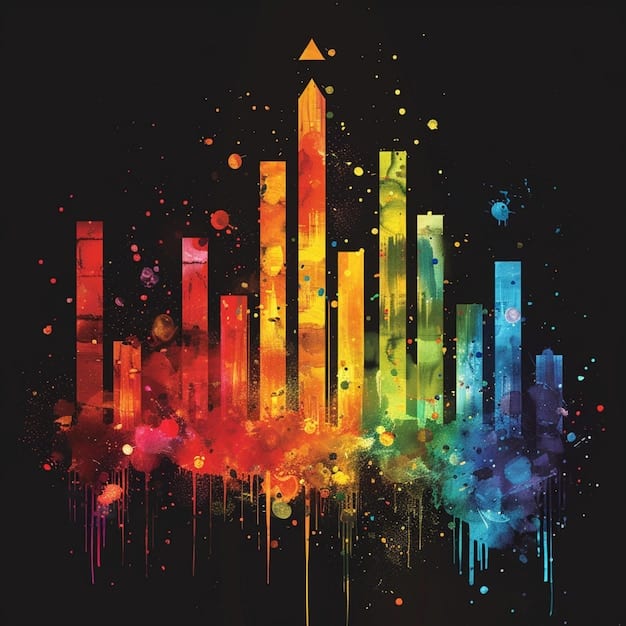Is Rock Dead? New Album Sales Data Reveals Surprising 12% Increase in 2025

Contrary to popular belief, 2025 data indicates the rock genre is experiencing a significant resurgence, with new album sales impressively increasing by 12%, challenging long-held assumptions about its standing in the contemporary music landscape.
For years, pundits and fans alike have debated the vitality of rock music. Is it a relic of the past, or does it still hold a powerful pulse in the modern era? Recent findings from 2025 album sales data present a compelling argument, revealing a surprising 12% increase, suggesting that rock is far from dead—it’s thriving.
The Persistent Question: Is Rock Truly Dead?
The perennial question, “Is rock dead?” has echoed throughout the music industry for decades. With the rise of pop, hip-hop, and electronic genres dominating charts, many have prematurely declared the demise of rock. However, this narrative often overlooks the genre’s enduring appeal and its remarkable ability to adapt and reinvent itself. The perception of rock’s decline often stems from a narrow view of mainstream success, ignoring the vibrant underground scenes and the consistent output of both established and emerging artists.
For a long time, the music industry has focused on algorithms and streaming numbers, which, while important, don’t always capture the full picture of a genre’s health. Rock, by its very nature, thrives on connection, live performances, and the tangible experience of physical media. This unique relationship with its audience might explain why conventional metrics sometimes miss its true strength. The recent sales data compels us to reconsider these long-held assumptions and dive deeper into what’s truly happening.
A Shift in Perspective and Metrics
To accurately assess rock’s status, we need to broaden our analytical lens. Traditional metrics like radio airplay and top 40 chart positions no longer paint a complete picture of musical success, especially for genres that cultivate dedicated fan bases. The digital age has diversified consumption patterns, allowing niche genres to flourish outside the mainstream spotlight. This shift necessitates a re-evaluation of how we measure a genre’s impact and commercial viability.
- Beyond Mainstream Charts: Rock’s influence often extends beyond the Hot 100, impacting film scores, video games, and youth culture.
- Streaming vs. Ownership: While streaming is prevalent, dedicated rock fans often prefer physical media, contributing significantly to album sales.
- Global Reach: Rock’s appeal is truly international, with strong markets in Europe, Asia, and South America, not just the US.
- Niche Communities: Online forums and independent platforms foster communities where rock thrives, supporting artists directly.
The conversation needs to move past a simple “yes” or “no” answer to the question of rock’s vitality. It requires an understanding of how music is consumed today and how rock has navigated these changes. The 12% increase in new album sales is not just a statistic; it’s a testament to the genre’s resilience and its deep-rooted cultural significance. It signals that artists are still finding ways to connect with audiences who crave the authenticity and energy that rock provides.
2025 Album Sales Data: Unpacking the 12% Surge
The latest 2025 album sales data has sent ripples through the music industry. A 12% increase in new rock album sales is an undeniable indicator of a genre that is not only surviving but flourishing. This unexpected surge demands a closer look into its underlying causes and what it signifies for the future of rock music. This isn’t a small fluctuation; it’s a substantial jump that challenges the prevailing narrative of rock’s irrelevance.
Several factors likely contribute to this impressive growth. One possibility is a generational shift, where younger listeners, perhaps tiring of established genres, are discovering the rich history and raw energy of rock. Another could be the successful marketing and touring efforts of both veteran bands and fresh faces in the rock scene, connecting with fans on a deeper level. The numbers suggest a renewed interest, perhaps catalyzed by a yearning for something more authentic in an increasingly digital and often manufactured music landscape.

Key Drivers Behind the Resurgence
Understanding the specific elements that propelled this growth is crucial. It’s not a single factor but a confluence of trends and strategic shifts that have reignited interest in rock. These drivers highlight a proactive movement within the genre to stay relevant and engaging for a new generation of listeners, while also retaining its loyal fanbase.
- Vinyl Revival: The continued resurgence of vinyl records provides a tangible, high-quality listening experience that appeals strongly to rock aficionados.
- Live Music Demand: Post-pandemic, live rock concerts and festivals have seen unprecedented attendance, fostering a renewed love for the genre.
- Genre Fusion: Many contemporary rock artists are successfully incorporating elements from other genres, like pop, electronic, and hip-hop, broadening their appeal.
- Nostalgia and Discovery: Older generations are revisiting their roots, while younger listeners are discovering classic rock through parents and online platforms.
The data itself tells a compelling story. While specific album titles and artists contributing most to this increase aren’t yet fully detailed, the overall trend is clear. This 12% isn’t an anomaly; it reflects a genuine shift in consumer preference and a strong validation of the artistic output within the rock community. It underscores the importance of physical sales and the enduring connection fans have with rock music, an aspect often underestimated in an era dominated by digital metrics.
The Evolving Sound of Rock: How Artists are Adapting
Rock music has always been a chameleon, constantly morphing and absorbing new influences. The 12% increase in sales isn’t just about old bands selling more records; it points to a dynamic evolution within the genre. Contemporary rock artists are not content to simply replicate past successes; they are experimenting with sound, lyrical themes, and production techniques, pushing the boundaries of what rock can be. This willingness to adapt is key to its continued relevance.
A new generation of rock artists is blending diverse styles, creating a sound that is both familiar and refreshingly new. This genre fluidity attracts listeners from various musical backgrounds, expanding rock’s demographic reach. Artists are incorporating modern production values, embracing digital tools, and collaborating with musicians from different genres, all while retaining the core energy and spirit that defines rock music. This balance between tradition and innovation is a delicate act, but when done right, it yields compelling results.
Innovation in Production and Lyrical Themes
Modern rock production has become increasingly sophisticated, moving beyond traditional band setups to embrace electronic elements, orchestral arrangements, and advanced mixing techniques. This sonic expansion allows for richer, more immersive listening experiences. Lyrically, artists are tackling contemporary issues, from mental health and social justice to technological alienation, making their music deeply resonant with today’s audiences.
- Digital Integration: Incorporating synthesizers, drum machines, and digital effects to create unique soundscapes.
- Cross-Genre Collaborations: Working with pop artists, rappers, and electronic producers to create fresh, unexpected sounds.
- Personal Narratives: A stronger focus on personal storytelling and vulnerability, fostering deeper connections with listeners.
- Social Commentary: Using music as a platform to address pressing societal concerns and inspire change.
The ability of rock to continually reinvent itself, absorbing new sounds and reflecting the times, is a testament to its artistic strength. It avoids becoming stagnant by embracing change, allowing new voices and perspectives to emerge. This continuous evolution ensures that rock remains a fresh and exciting genre, capable of capturing the attention of both long-time fans and newcomers.
The Role of Independent Labels and DIY Culture
While major labels still play a significant role, the 12% surge in rock album sales owes much to the robust independent scene and the enduring DIY (Do It Yourself) ethos. Independent labels often provide a nurturing environment for artists who might not fit mainstream molds, fostering creativity and experimentation. This allows for a diversity of sound and a more authentic connection with niche audiences, which collectively can make a substantial commercial impact.
The internet and readily available recording technology have democratized music production and distribution. Artists no longer need a major label deal to reach an audience; they can record, produce, and market their music independently. This has led to an explosion of talent and subgenres within rock, catering to a wide array of tastes. The independent scene is where much of the genre’s innovation and raw energy can be found, acting as a vital incubator for the next wave of rock stars.
Empowering Artists and Connecting with Fans
Independent labels and DIY culture empower artists by giving them greater creative control and better revenue splits. This model often results in music that is more genuine and less compromised, resonating deeply with fans who value authenticity. Direct-to-fan sales, crowdfunding, and accessible touring options further strengthen the bond between artists and their audience.
- Creative Freedom: Independent artists often have full control over their musical direction, lyrical content, and visual aesthetics.
- Direct Fan Engagement: Platforms like Bandcamp and Patreon enable direct financial support and communication between artists and fans.
- Grassroots Marketing: Word-of-mouth, local shows, and independent radio remain powerful tools for building a dedicated fan base.
- Community Building: The DIY scene fosters strong, supportive communities of musicians and fans, essential for genre growth.
The success of independent rock artists demonstrates that commercial viability doesn’t solely depend on immense corporate backing. It highlights the power of passion, community, and direct artist-fan relationships. This segment of the industry is a crucial driver in rock’s resurgence, showcasing how dedicated talent, even without a massive budget, can achieve significant commercial gains through focused effort and genuine artistry.
Live Performances and Festival Culture: Rock’s Unifying Force
The undeniable energy of a live rock show is unlike any other musical experience. In a world increasingly saturated with digital content, the communal experience of live music stands out as a powerful unifying force. The 12% in album sales correlates perfectly with the robust health of rock festivals and concerts, demonstrating that physical presence and shared moments are more important than ever for the genre’s vitality. Live music provides a direct, visceral connection that streaming alone cannot replicate.
For many, rock music isn’t just about listening; it’s about experiencing. From small club gigs to massive outdoor festivals, live performances are where rock truly comes alive. The raw emotion, the collective energy of the crowd, and the sheer power of amplified instruments create an unforgettable atmosphere. This shared experience deepens fan loyalty and serves as a powerful evangelist for the genre, drawing in new listeners who witness its magnetic appeal firsthand.
The Enduring Appeal of Rock Festivals
Rock festivals have grown into major cultural institutions, drawing hundreds of thousands of attendees annually. These events showcase a diverse range of rock subgenres, from classic rock acts to cutting-edge new bands, creating a powerful platform for discovery and celebration. Festivals are crucial for uniting the rock community and exposing artists to wider audiences, converting casual listeners into devoted fans.
- Shared Experience: Festivals offer a unique communal vibe, strengthening the bond between fans and artists.
- Discovery Platform: Attendees are exposed to new bands they might not have otherwise encountered.
- Economic Impact: Festivals contribute significantly to album sales and merchandise revenue, supporting artists directly.
- Cultural Significance: They represent a vibrant convergence of music, art, and community, embodying the rock spirit.
The strong performance of rock in the live arena directly impacts album sales. When fans connect with an artist at a concert, they are more likely to seek out their recorded material, purchase merchandise, and follow their career. This symbiotic relationship between live performance and recorded output highlights a fundamental truth about rock consumption: it thrives on immersive, real-world engagement, reinforcing its status as a genre built on shared experience and tangible passion.
The Resurgence of Physical Media: Vinyl’s Enduring Charm
The discussion about rock’s recent growth would be incomplete without acknowledging the monumental impact of physical media, particularly vinyl records. The 12% increase in new album sales for 2025 aligns perfectly with the ongoing vinyl revival, which has seen sales of LPs soar for over a decade. Vinyl offers a tactile, high-quality audio experience that resonates deeply with rock fans, providing a sense of ownership and connection that digital formats often miss.
For many rock enthusiasts, the ritual of unboxing a new record, reading the liner notes, and carefully placing the needle on the groove is an integral part of the listening experience. This isn’t just nostalgia; it’s an appreciation for art as a complete package, encompassing sound, artwork, and physical presence. Vinyl embodies the commitment and craftsmanship often associated with rock music, making it the preferred format for many dedicated fans who invest emotionally and financially in their favorite artists.
Why Vinyl Sales Bolster Rock’s Commercial Health
Vinyl’s appeal extends beyond mere sound quality. It taps into a desire for tangible connection in an increasingly digital world, offering a collecting aspect and a sense of permanence that fleeting digital files cannot provide. This preference for physical formats makes rock music a significant beneficiary of the vinyl boom, as its demographic often overlaps with vinyl collectors.
- Superior Audio Quality: Many audiophiles prefer the warm, rich sound produced by vinyl records.
- Collectibility: Limited editions, colored vinyl, and elaborate packaging make records desirable collector’s items.
- Artistic Presentation: Large album art and detailed liner notes offer a more immersive artistic experience.
- Ritual and Connection: The act of playing a record creates a personal, intentional listening experience.
The sustained growth in vinyl sales, particularly for rock albums, underscores a crucial point: not all music consumption is equal. For a significant portion of rock listeners, the physical artifact—the album—is still a primary means of engaging with the music and supporting artists. This trend suggests that while digital streams have their place, the enduring charm and perceived value of vinyl continue to be a powerful, and increasingly important, driver of rock’s commercial success, directly contributing to the surprising 12% sales increase.
Future Outlook: Sustaining Rock’s Momentum Beyond 2025
The 12% increase in new album sales in 2025 is not just a momentary spike; it’s a foundation upon which rock can build a sustainable future. For the genre to maintain and even accelerate this momentum, artists, labels, and fans must continue to innovate, adapt, and champion its unique spirit. The path forward involves a blend of embracing new technologies while honoring rock’s rich traditions, ensuring its appeal for generations to come.
Sustaining this resurgence requires a proactive approach from all stakeholders. Artists must continue to push creative boundaries, exploring new sounds and engaging with contemporary themes. Labels, both major and independent, need to invest in diverse talent and innovative marketing strategies. And fans, the ultimate custodians of any genre, must continue to support artists through purchasing music, attending live shows, and spreading the word. The collective effort will determine rock’s long-term trajectory.
Strategies for Continued Growth and Relevance
To ensure rock’s ongoing vitality, several key strategies can be implemented and strengthened. These initiatives focus on expanding reach, fostering new talent, and leveraging technology to enhance the rock experience, ensuring the genre remains dynamic and appealing.
- Nurturing Emerging Talent: Providing platforms and resources for new rock bands to develop and gain exposure.
- Strategic Digital Presence: Utilizing social media, streaming playlists, and online communities to reach wider audiences.
- Educational Initiatives: Promoting rock music in schools and youth programs to foster early appreciation.
- Inter-Genre Collaborations: Encouraging artists to work across genres to create fresh sounds and broaden appeal.
- Investment in Live Venues: Supporting local music venues and national touring circuits to ensure consistent live performance opportunities.
Ultimately, the future of rock lies in its adaptability and its ability to connect with listeners on a visceral, emotional level. The 12% sales increase in 2025 is a powerful indicator that rock still resonates deeply, offering a unique blend of raw energy, passionate expression, and enduring cultural relevance. By continuing to evolve while staying true to its core, rock can confidently look forward to a vibrant and impactful future, proving once again that it is very much alive.
| Key Insight | Brief Description |
|---|---|
| 📈 Rock Sales Surge | 2025 data shows a surprising 12% increase in new rock album sales, defying “rock is dead” narratives. |
| 🎸 Evolving Sound | Artists adapt through genre fusion, modern production, and relevant lyrical themes, attracting new audiences. |
| ✊ Indie Power | Independent labels and DIY culture empower artists, fostering creativity and direct fan connections. |
| 💿 Vinyl Revival | The continued resurgence of physical media, especially vinyl, significantly boosts rock’s commercial health. |
Frequently Asked Questions About Rock’s Resurgence
The claim is primarily supported by new album sales data from 2025, which indicates a surprising 12% increase in rock album purchases. This figure challenges the long-standing narrative about the genre’s decline, showing a tangible growth in consumer interest and investment in rock music.
Modern rock artists are adapting by incorporating genre fusion, blending rock with elements from pop, electronic, and hip-hop. They also embrace contemporary production techniques and tackle relevant lyrical themes such as mental health and social commentary, making their music resonate with current audiences.
Independent labels and DIY culture are crucial. They provide creative freedom for artists, fostering experimentation and authentic music that appeals to niche audiences. This allows for diverse sounds and direct fan engagement, making a significant collective impact on album sales and genre growth.
Yes, the vinyl revival is a significant factor. Rock music fans often prefer physical media, particularly vinyl, for its tactile experience, superior audio quality, and collectibility. This trend aligns perfectly with the 12% increase in sales, as enthusiasts invest in tangible albums over purely digital formats.
Sustaining momentum requires nurturing new talent, investing in live venues, and utilizing strategic digital presence. Continued genre fusion and educational initiatives are also key. By embracing innovation while honoring its roots, rock can ensure its ongoing relevance and appeal for future generations.
Conclusion: Rock’s Resounding Comeback
The question of whether rock music is dead has been definitively answered by the remarkable 2025 album sales data. With a surprising 12% increase, the genre has demonstrated not just resilience, but a vibrant and undeniable resurgence. This growth is a testament to the ongoing evolution of rock—its artists’ willingness to innovate, the power of independent scenes, the enduring appeal of live performances, and the nostalgic yet ever-relevant charm of physical media like vinyl. Far from being a relic, rock continues to adapt, inspire, and captivate new generations, solidifying its place as a cornerstone of musical culture. The future of rock is not just alive; it’s rocking harder than ever.





